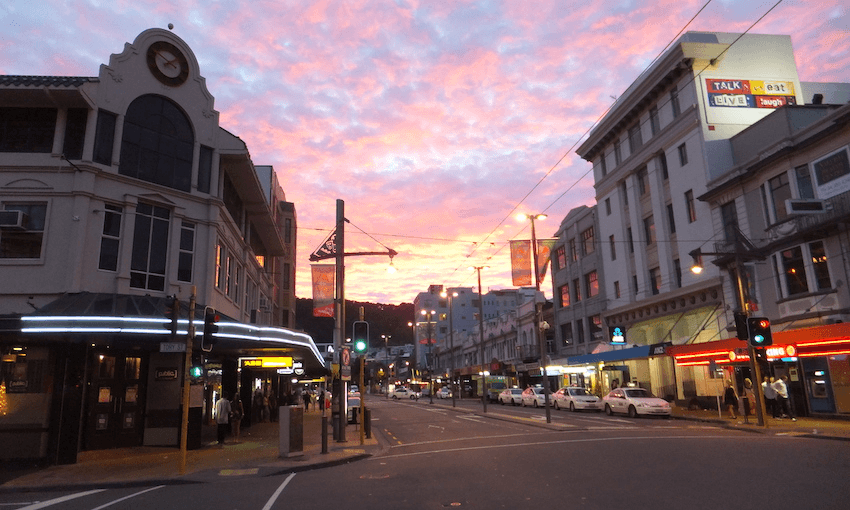Sam Brooks reviews our capital’s most iconic stretch: Courtenay Place.
Every city in the country has that one place that after a certain age, a certain income bracket, or a certain night, that you just know to avoid. If you’re in Auckland, it’s the Viaduct. Dunedin? The Octagon. Christchurch? The Terrace, formerly The Strip. Hamilton? The vague area between Huntly and Cambridge.
For Wellington, it’s Courtenay Place. It cuts through the centre of the capital like a scar; somewhere you have to cross to get anywhere. You wanna get to Lambton Quay? You’ll probably end up scuttling across Courtenay Place, be it by foot or by vehicle. Some of the best restaurants and bars in the country can be found, well, not on Courtenay Place, but at least around it. And they sit right amongst places doing $6 handles or two-for-one cocktails, where the floors stick to your shoes like regrets on a Sunday morning (or Thursday morning, age depending).
Some slightly shady editor on Wikipedia says that the street is known for its “entertainment, nightlife and ill-designed footpaths”. Wellington’s own website/cultural capital propaganda website, Wellington NZ, speaks of the 450m strip thusly:
“When the sun goes down and the lights come on, Courtenay Place comes to life. It’s where Wellington goes to celebrate, relax and catch up with friends.”
I think you’ll find that’s Cuba Street, Wellington NZ. There’s not a single conversation that’s been had on Courtenay Place by moonlight that wouldn’t be better had by daylight on Cuba Street. You know it to be true.
Me, a lifelong Aucklander but casual Wellingtonian (fun for a night, not for a life), has spent many a night on, or at the very least around, Courtenay Place. And before you question my credentials, I’ll let you know that I’m not a curly-fries-at-Sweet-Mother’s, shake-at-Fidel’s Aucklander. I’m a why-the-hell-is-nowhere-good-open-at-3pm-for-coffee Aucklander.
Courtenay Place, like Batman/Bruce Wayne, is at its truest form by night. The takeout places with screens teem, and the kebab places deal with the overflow. Bouncers line guys in Chucks and girls in heels up against walls, in vain attempts to keep the “ill-designed” footpaths clear. People stumble around in coats – even on those fabled Wellington good days, you need a coat – and wait for pizza-branded pizza on the corner of Taranaki and Courtenay.
Night is when the ghosts of Courtenay Place rise and rumble. The now derelict Burger Kings burst at the seams with memories both wholesome and distasteful (and let’s be honest, the Burger King in the old bank building was Courtenay Place in spirit, if not physical location). The skeleton of Reading Cinemas sits like a dinosaur in a museum, hundreds of empty seats facing permanently back screens. The most haunting, in a post-quake, post-lockdown life, are the signs hanging on storefronts, wailing like dogs at the pet shop for the next would-be entrepreneur. The city of BK has become the city of “For Lease”.
No matter what changes, the constants remain. The reliable alphabet of 3AM remains there for your post-drinking recovery, although KC and J&M are joined now by KFC. Estab (never referred to by its full Christian name) ushers people in from the cold and into oblivion; no bar has ever been more grateful for our country’s liberal attitude towards course-related costs. The pedestrian lights on Taranaki Street, not made for people but for the Wellington wind, turn red before any human can possibly cross them. The heritage buildings stand sentinel, a St. James here, an Embassy there; more useful as landmarks for the tipsy than as remembrances of a cultural capital.
Then the sun rises and Courtenay Place takes off its cowl and turns from Batman right back into boring old Bruce Wayne. Daytime is Courtenay Place’s hangover, regardless of the day. It’s full of dust from the previous night’s escapades.
By day, the chains are open. The fast-food places with screens recover; they’re the friend who holds your hair back over the toilet bowl. The bars sluggishly yank themselves open and the regulars drift in, ill-designed footpaths be damned. Despite the road works, the blue tarps and pink foam that are the coffin and flowers on the Tory Street BK, there’s a sort of beauty to Courtenay Place by daylight.
Take Estab, if you will. By night, it’s full of people whose studies lead them into working for the titular establishment, or working to disestablish it. By day, it’s full of men who at some stage wish they were part of the establishment, but have since settled for the abbrev.
At day, Courtenay Place feels like what it is: an institution. It feels like all the high and low of Wellington shoved into a 450-metre stretch, even if the high is about as far away from a brutalist bus-stop as you are from the device you’re reading this on (looking at you, Hummingbird). You’re a stone’s throw from the best and worst of the country’s places to have a drink or ten, and within spitting distance from some of the nation’s worst forgotten memories.
And like most of Wellington, if you want to enjoy it, all you need is a coat, a couple of friends and waterproof boots.

